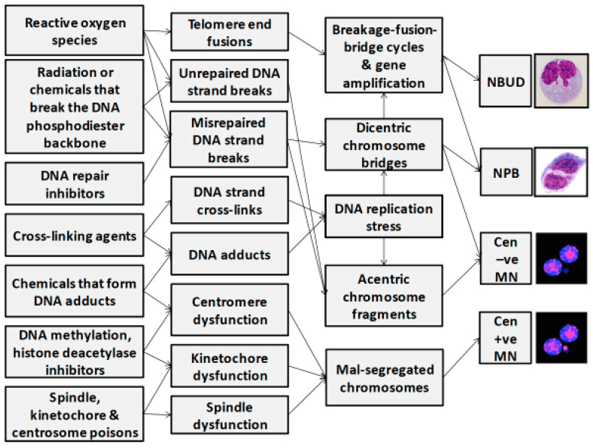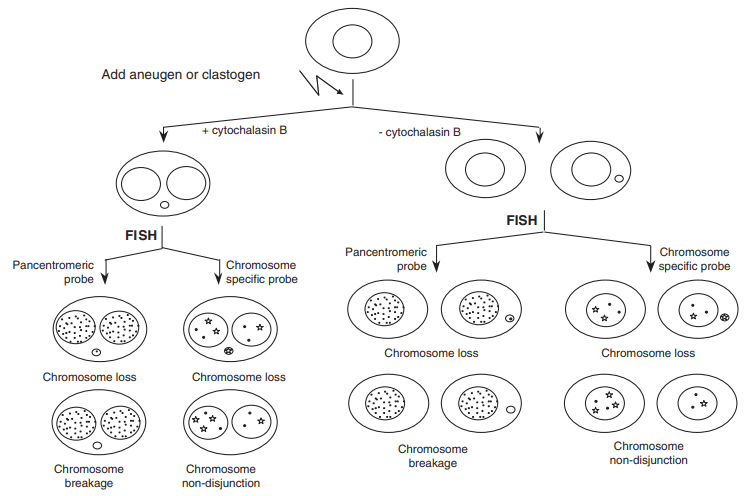FISH and Micronucleus Assay
Mosaicism Assay and Chromosomal Damage
Many chemicals, physical or biological factors can cause cell death. However, there is a class of factors that can destroy the genetic material of a cell but not necessarily kill the cell. These factors are called genotoxins, and their effects on humans and biological groups can be assessed through genotoxicity testing. Micronucleus (MN) is derived from the entire chromosome or chromosome fragments that cannot be separated into the cell during mitosis. The Micronucleus test is one of the most effective cytogenetic techniques for evaluating chromosome instability and damage and has become a mainstream technique for evaluating the genotoxicity of different chemical and physical factors (including DNA damage induced by ionizing radiation). MN is a small body produced when dividing cells. These cells have no centromere chromosome fragments and complete chromosomes that are lagging behind and are not included in the daughter nucleus. Compared with chromosomal aberrations, MN scores are simpler and less time-consuming. Now MN testing is widely used in genetic toxicology testing, radiation biological dosimetry, and population biological monitoring. The conventional MN test cannot describe the chromosome content of MN. The combination of micronucleus test and DNA probe in situ hybridization can improve this situation.
 Fig 1. Molecular mechanism of formation in lymphocytes. (Fenech M, et al. 2020)
Fig 1. Molecular mechanism of formation in lymphocytes. (Fenech M, et al. 2020)
FISH Services and Mosaicism Assay
Somatic chromosome mosaicism and chromosome instability have become the focus of current biomedical research. The Micronucleus test is also called in vivo genotoxicity test. The combination of MN detection and FISH can characterize the appearance of different chromosomal materials in MN. It also allows distinguishing between non-embryonic effects and cleavage effects. Centromeric and telomere DNA probes, chromosome staining, spectral karyotype analysis, and multicolor FISH have been used for chromosome analysis of MN. Our FISH analysis platform provides a variety of solutions for the analysis of micronuclei in samples.
Our interphase FISH solution can be used to solve the spontaneous level of chromosomal variation between cells, chromosomal mutations, or somatic chromosomal mosaicism. A set of chromosome-specific probes can be used for micronucleus analysis. Chromosome instability leads to the diversification of karyotype changes among somatic cells. iFISH can help clarify the research of the mechanism of chromosome mosaicism and instability. This service is mainly for cell samples, and we complete this test through a series of centromere probes. The general service process includes sample preparation (technical support), FISH hybridization, imaging, and data analysis.
 Fig 2. Detection of chromosome loss and chromosome nondisjunction in the cytokinesis-block micronucleus assay combined with FISH. (Decordier I, et al. 2011)
Fig 2. Detection of chromosome loss and chromosome nondisjunction in the cytokinesis-block micronucleus assay combined with FISH. (Decordier I, et al. 2011)
Applications of Mosaicism Assay
- The genotoxicity of antitumor drugs, especially the evaluation of micronucleus induction;
- Aquatic pollutants have multiple consequences at the level of organisms, populations, communities, and ecosystems, affecting organ function, reproductive status, population size, species survival, and biodiversity;
- Micronucleus analysis after radiation treatment to evaluate the degree of DNA damage caused by radiation;
- Cytokinesis blocked micronucleus (CBMN) determination;
- Somatic cell chromosome mosaicism is a sign of aging and failure to maintain genome stability, so it can be used in aging-related research;
Creative Bioarray provides a variety of interphase FISH solutions to help customers study the mechanism of micronucleus-related events. This service is combined with traditional micronucleus testing to help customers conduct research related to somatic genetic instability. If you are interested in our FISH service, please contact us for cooperation. We look forward to cooperating with you in the near future.
References
- Fenech M. Cytokinesis-Block micronucleus cytome assay evolution into a more comprehensive method to measure chromosomal instability[J]. Genes, 2020, 11(10): 1203.
- Decordier I, Mateuca R, Kirsch-Volders M. Micronucleus assay and labeling of centromeres with FISH technique[J]. Drug Safety Evaluation, 2011: 115-136.
- Hovhannisyan G, Harutyunyan T, Liehr T. Micronucleus FISH[M]//Fluorescence In Situ Hybridization (FISH). Springer, Berlin, Heidelberg, 2017: 379-383.
All products and services on this website are only suitable for non-medical purposes.


 Fig 1. Molecular mechanism of formation in lymphocytes. (Fenech M, et al. 2020)
Fig 1. Molecular mechanism of formation in lymphocytes. (Fenech M, et al. 2020) Fig 2. Detection of chromosome loss and chromosome nondisjunction in the cytokinesis-block micronucleus assay combined with FISH. (Decordier I, et al. 2011)
Fig 2. Detection of chromosome loss and chromosome nondisjunction in the cytokinesis-block micronucleus assay combined with FISH. (Decordier I, et al. 2011)


